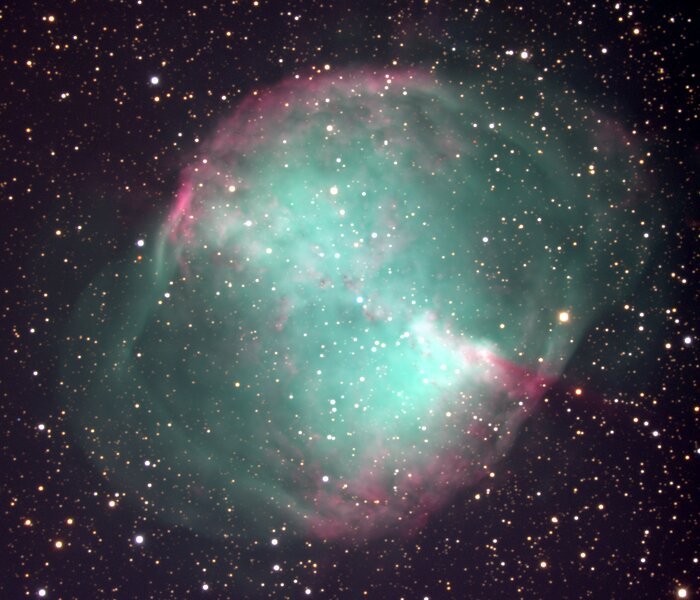M27, the Dumbbell Nebula, is a one of the easiest planetery nebulae to spot in the night sky with small optical instruments, such as binoculars. The nebula was discovered by the French astronomer Charles Messier on July 12, 1764. He initially mistook it for a comet but later realized its true nature as a nebula. Here’s an overview of this fascinating DSO:
Location and Visibility
M27 is located in the constellation Vulpecula. It’s relatively easy to find, lying between the bright stars Albireo (in Cygnus) and Altair (in Aquila). With an apparent magnitude of 7.5, it’s one of the brightest planetary nebulae in the night sky and is visible with binoculars or small telescopes.
Structure and Composition
M27 is a planetary nebula, formed from the outer layers of a dying star that were expelled into space as the star evolved into a white dwarf. The central star of M27 is a white dwarf with a surface temperature of about 85,000 Kelvin, which ionizes the surrounding gas and causes it to glow.
The nebula has a bipolar structure, with two main lobes of gas extending from a central region. It also exhibits fainter extensions of gas beyond the main lobes, giving it a more complex and dynamic appearance. It gets its name from its appearance, resembling the shape of a dumbbell or hourglass.

Evolution and Future
Like all planetary nebulae, M27 will continue to expand and dissipate over time. The central white dwarf will eventually cool down and fade, becoming a dark remnant in the centre of the nebula. The ejected material from M27 will eventually mix with the interstellar medium, enriching it with heavy elements synthesized in the star’s core.
Observation
M27 is a popular target for amateur astronomers due to its brightness and distinctive shape. Even small telescopes reveal its hourglass shape and reveal some of its finer details.
M27 is well-placed for observation during the summer and autumn months (June to October) in the Northern Hemisphere. In the summer, it starts becoming visible in the late evening hours and remains observable throughout the night. As summer progresses, it continues to rise earlier in the evening, providing ample opportunities for observation.
While summer is a good time to observe M27, the constellation Vulpecula, reaches its highest point in the sky around late September to early October, offering even better views of the nebula under darker skies and longer nights.

Choose nights with clear skies and minimal light pollution for optimal viewing conditions. Light pollution can significantly diminish the visibility of faint objects like nebulae, so try to observe from locations away from city lights if possible. Aim to observe during moonless nights or when the Moon is in its crescent phase, as this reduces its brightness and allows for better visibility of faint celestial objects.
Familiarize yourself with the constellation Vulpecula, where M27 is located, to help you locate it more easily. Use star charts, planetarium apps, or astronomy software to identify its position relative to prominent stars and constellations.
Observing faint celestial objects like M27 requires patience and adaptation to the dark, so allow your eyes to adjust to the darkness for better visibility, and take your time to scan the sky systematically.
Overall, the Dumbbell Nebula, is a fascinating object to observe in the night sky. Its relatively bright and distinct appearance makes it a favorite among both amateur and professional astronomers.



